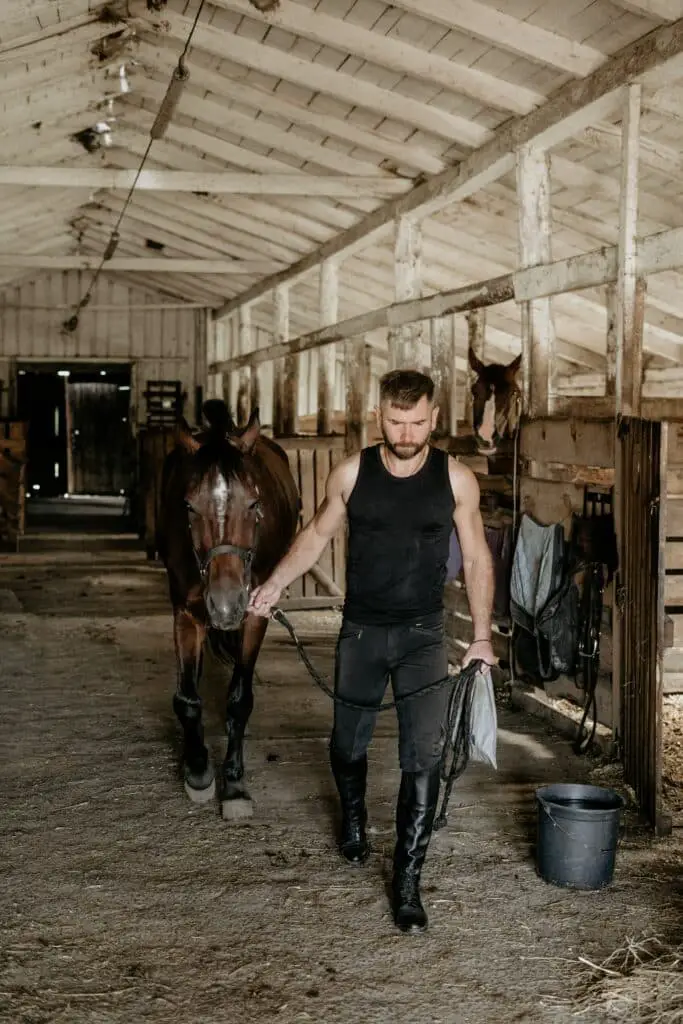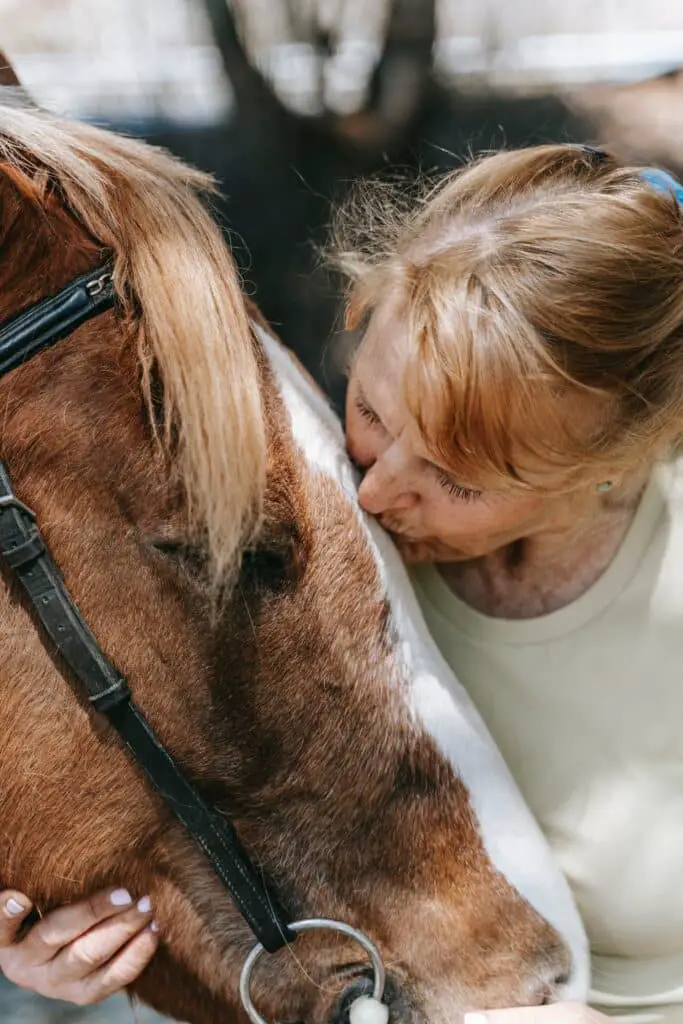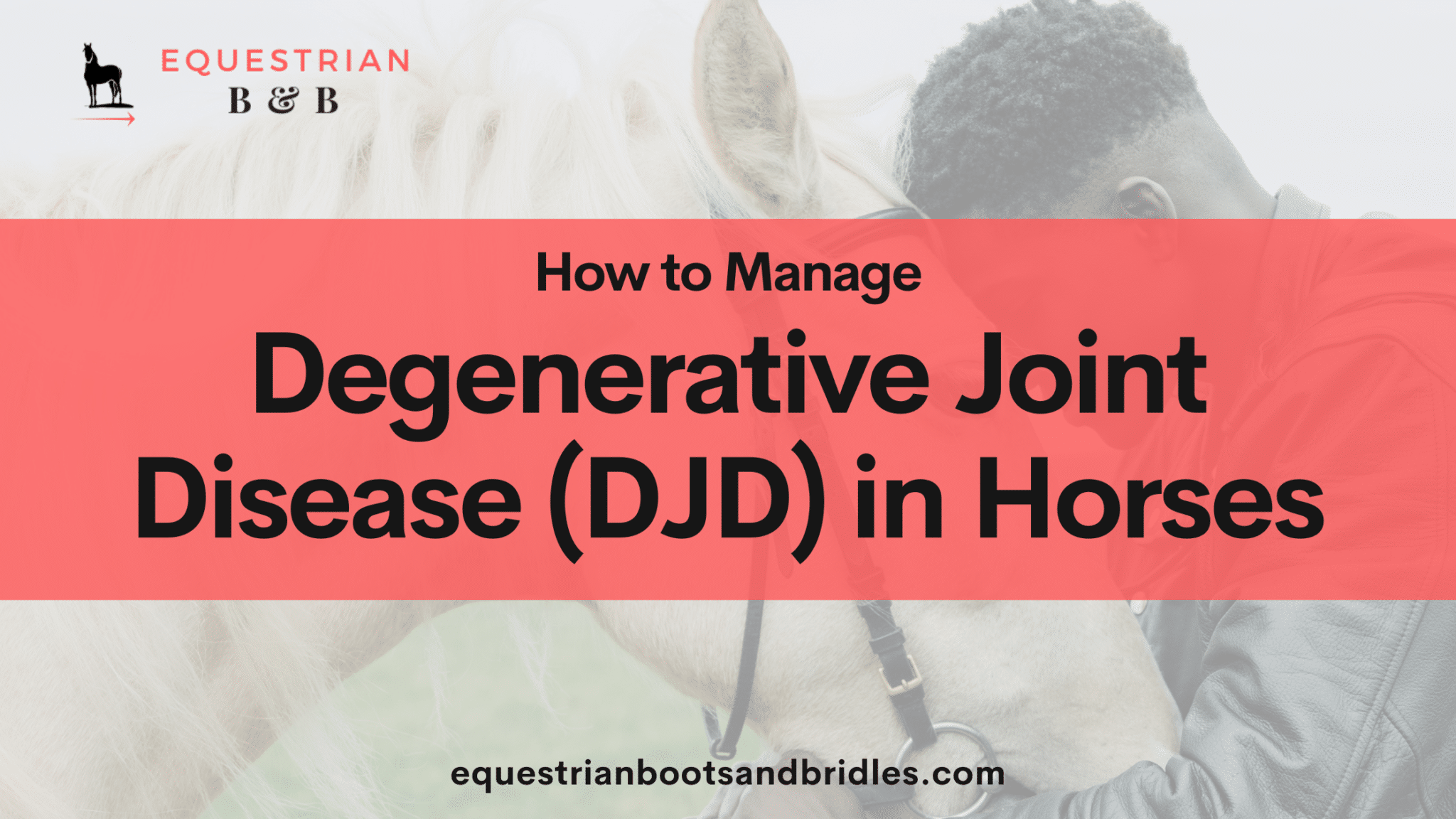When I recently helped a rider at the yard with their young sport horse, I was surprised to notice severe lameness centered around the horse’s hock with all the early markers of arthritis. This was certainly not something I’d expect from a four-year-old sport horse.
Curious, I dove into further study of degenerative joint disease, or DJD, in horses. There’s good reason for horse owners to get nervous when they hear words like arthritis, osteoarthritis, and degenerative joint disease.
Here are the facts about symptoms, treatment, and causes of DJD. Your horse depends on you to have the knowledge and answers to help them remain comfortable and mobile.
As always, the information in this article is for informational purposes only and should not be considered medical advice for your horse. You should always consult with your vet when treating your horse.
What Is Degenerative Joint Disease in Horses (DJD)?
Degenerative joint disease in horses is also known as osteoarthritis. It’s the final step in the degradation of the horse’s joints, and it’s also the most painful. Osteoarthritis is when the joint has degraded to the point where the bones are affected and the joint integrity has become questionable.
Depending on the stage of degradation that the joints have reached, there may be treatments to support and maintain the joint to a moderate level of comfort. Or, if the condition is too far in its degeneration, the horse may have to be put to sleep (euthanized).
All horses have some wear and tear on their joints. However, with DJD, there is substantially more damage, specifically focused on the joint integrity and cartilage health. The joint becomes compacted, bone growth develops as rigid spurs that are painful, bone fragments chip off, and the joint fluid (synovial fluids) loses lubrication or leaks out if the joint capsule is damaged.
Joint pain results from decreased joint space, increased joint pressure, and bone-on-bone grinding that occurs when the joint no longer supports healthy cartilage or there’s no thick synovial fluid that’s needed for lubrication and protection.

Signs and Symptoms of Degenerative Joint Disease or Osteoarthritis in Horses
For early diagnosis of DJD, it is vital that you can tell the early signs and act accordingly. Look for:
1. Lameness of the Horse
Horses quickly become lame when the first signs of DJD appear. Lameness results from loss of flexion in the affected joint, loss of joint integrity, and pain. At first, the lameness may be subclinical, with mild symptoms only. However, repeated lameness should be taken seriously.
2. Stiffness of the Horse
Normal joint function may be compromised, resulting in joint stiffness. Inflammation may also trigger stiffness as the joint capsule becomes swollen and the horse experiences pain and may struggle to stand.
3. Joint Swelling in Horses
Knees and hocks are popular joints where the horse may experience inflammation as a result of injury or pressure and friction in the joint capsule. The inflammation response of the horse’s immunity begins to target the cartilage layer that lines the bone ends, causing fractures and weakening of this spongy tissue, stripping the joint of its ability to absorb compression and vibrations.
A horse that suddenly presents swollen joints or a swollen joint may have suffered an injury, or the inflammation has reached the levels where swelling results.
Younger horses showing signs of DJD are becoming more commonplace than before, since young horses are worked too hard before their joints are fully formed. Even the environment that horses are raised in can cause negative development of the joints. Foals can even present with developmental orthopedic lesions, where the immature joint cartilage separates and forms lesions due to insufficient movement.
Genetic predisposing cartilage damage can result from poor breeding, and affected horses may suffer from a young age due to early onset of the degenerative disease. Knees and pasterns are often affected, while hocks can suffer due to poor conformation that places additional pressure on the joints from a young age.
How Does Osteoarthritis Develop?
For a better understanding of osteoarthritis and the inner workings of DJD, it’s important to understand how a healthy joint works for a horse.
Horses have synovial or diarthrodial joint mechanisms. The structure of their joints is movable, providing flexibility and movement. Two bone endings meet at the joint, and the ends are covered with articular cartilage, which is a soft spongy tissue that is like bone but can absorb more pressure and concussion. When pressure builds in the joint, the cartilage cushions the bones, reducing the force the bones connect with.
To add to the “springy” nature of the joint, the two bones are sealed in a joint capsule made from a hardened fibrous tissue to protect the delicate structures. Inside this capsule is a thick and oily substance known as hyaluronan that is mixed with the joint fluid or synovial fluid. The movable joints are supported and cushioned in this dense oily chamber with the cartilage forming the movement surface or articular surfaces.
Sound complex? It is. And this simplistic explanation doesn’t really cover the tendons and supporting ligaments that also interact at the joint site.
When osteoarthritis develops, it usually starts as regular inflammation that goes untreated to become arthritis. With long-term arthritis, damage is done to the joint structure because the heat from inflammation will increase pressure on the joint capsule.
The synovial fluid loses its lubrication properties and the thick and slippery characteristics of the hyaluronan also weakens, causing more impact to the articular cartilage layer that lines the bone ends. The cartilage layer starts to suffer fractures as a result of working harder than it should. Further inflammation starts as the horse’s body tries to repair the cartilage, but this merely worsens the situation.
Uneven bone regeneration happens, and the cartilage layer forms spurs or bone spavin that cut into the joint even more, causing severe pain. The extra bone growth in the joint narrows the joint space, affecting the stability of the affected limbs.
Sadly, DJD or osteoarthritis is degenerative, which means the condition can’t naturally reverse and it continues to weaken the joints, placing further strain on the healthy joints as the horse tries to compensate. In the end, movement becomes a painful challenge.
Causes of Degenerative Joint Disease in Horses
While there is still some debate on what exactly causes DJD or osteoarthritis, the consensus seems to be that the following conditions will cause conditions that can damage the joint capsule and lead to stiffness, lameness, and pain.
1. Carrying Heavy Loads
When horses carry heavier weight than they should, they place more pressure on their joints, which can lead to joint damage and inflammation as a result of microfractures.
2. Hyperextension of the Leg Joints
Racehorses, cutting horses, jumpers, and barrel racers often struggle with joint degeneration in the horse’s knees, hocks, and pastern joints. Stifle joints often get damaged by carrying heavy riders or sudden turning and twisting movements.
3. Repeated Concussive Forces on the Joint
When the horse is exposed to working over hard ground, they suffer more concussive force from each stride, which can potentially damage the joint cartilage. As the damaged articular cartilage heals, the joint becomes thickened, only to break again because of more concussion.
4. Inflammation or Infection From Joint Injuries
Injuries, particularly deep penetrating punctures and wire cuts, can lead to infection and inflammation, which forms arthritis known as septic arthritis. The chronic inflammation causes the bones to weaken and synovial fluids to thicken and even drain from the puncture site or rupture from the joint capsule.

Treatment Options for Degenerative Joint Disease in Horses
When DJD is identified and diagnosed early, the best treatment is to stop all strenuous exercise. While mild exercise is good to maintain mobility in the joints, horses with osteoarthritis or inflammation in the joint due to a laceration or puncture will need long-term rest to allow the joint to naturally stabilize and recover.
Administering nonsteroidal anti-inflammatory drugs can help reduce inflammation, while also supporting healing in the joint. When the inflammation and swelling has lessened, the horse will feel relief from the pain.
Some owners opt for joint injections with combinations of anti-inflammatory drugs and hyaluronic acid, which can help reduce pain and inflammation almost immediately. There is risk when puncturing the fibrous capsule of the joint with a syringe for the injection, as this can lead to infective arthritis where the joint becomes infected.
Protecting and caring for the joint environment is a primary concern when your horse shows signs of DJD. Nourishing the membrane that makes synovial fluid will help reduce friction in the joint. A shortage of synovial fluid increases friction, which causes pain.
Other treatment protocols also include:
1. Feeding Joint Supplements
To maintain the health and consistency of joint fluid, start by adding joint supplements that help relieve pain and promote flexibility. Omega acids are ideal for helping to lubricate the joints while also regenerating the synovial fluid and ensuring the correct consistency.
Dietary supplements that contain cartilage-forming nutrients such as collagen and biotin are ideal for overall joint health and to boost speedy recovery from cartilage damage.
Preventing inflammation is one of the first steps to treating an arthritic joint that is developing DJD. The inflammation reaction of inflammatory cells degrade hyaluronan, which lessens the lubrication of the synovial fluid and compromises the production of joint fluids from the synovial membrane.
2. Protect the Joint When Working
If your horse is prone to injuring themselves, you will have to make provision so they don’t inflict chronic damage. Protective shoeing and targeted farrery can also help prevent further injuries, which can cause inflammation. Over-reach boots, tendon boots, and exercise wraps are all ideal to protect a compromised joint, but ensure you remove them as soon as your training is done, as these coverings all increase the joint temperature.
Improving joint stability by using boots can help prevent the development of traumatic arthritis resulting from injuries.
3. Maintenance of the Joint
If your horse has mild DJD, you can still continue to ride them once the first symptoms have settled or passed. However, regular assessment by your vet should become routine, and you should also treat the horse’s legs and joints with extra care. Cold hosing, ice baths, and liniments should be applied religiously after each training or riding session.
Consider changing riding disciplines to help your horse transition to a less strenuous exercise. If you do barrel racing, consider changing to a Western pleasure class. Race horses can change to dressage or become happy hacking horses.
Reducing the impact the horse’s joints face each day will help prolong the inevitable.
4. When Should You Consider the Final Step?
Degenerative joint disease is a disease that will continue to worsen. The verdict on healing from DJD is not great. At some point, when the disease has run its course, you will have to make a decision whether to keep up with the supportive treatments or finally end the horse’s suffering. Your vet will be the most informed person to speak to about when it’s time.
In the end, it’s a personal decision you should make with your vet. You wouldn’t want your horse to suffer, so if they are struggling to move, lie down, or stand up, it may be time.

More FAQs About DJD
Is degenerative joint disease in horses only found in old horses, or can young horses also be affected?
Degenerative joint disease is not an “old” horse problem. Young horses can also develop early onset DJD if they are incorrectly raised, fed poorly, or overfed. Genetic factors may also make them predisposed to DJD.
What can I do to help my horse with DJD cope with pain?
Regular injections with anti-inflammatory medications may help relieve pain in the affected joints. Maintenance that involves applying liniments after exercise, ice baths, and cold hosing can all help reduce the pain causing inflammation.
My horse has a stiff hind leg; can it be arthritis when it’s only localized on one joint?
While arthritis can occur gradually and in all joints, it can also target a particular joint or limb. Sudden onset of swelling and pain in one joint can be injury related. A horse that’s fallen, twisted a joint, or suffered a penetrating injury can easily develop inflammation or infection that causes arthritis or osteoarthritis.
Final Thoughts on Degenerative Joint Disease in Horses
Degenerative joint disease is a diagnosis that no horse owner wants to hear, but ignoring the signs will only shorten your horse’s “good years.” Therefore, be proactive, and if you suspect DJD, get your horse the help they need. Early use of injections into the joint capsule can help limit the degradation of the joint cartilage layers, which will reduce the pain and inflammation your horse suffers.
Making wise dietary choices for your horse, providing them with sufficient turnout space and time, and supporting the joints can also help prolong your horse’s pain-free days. With great care, your horse can still have many years of continued work and life without pain and discomfort.
Like this post? Save it on Pinterest. Follow me on Pinterest.


